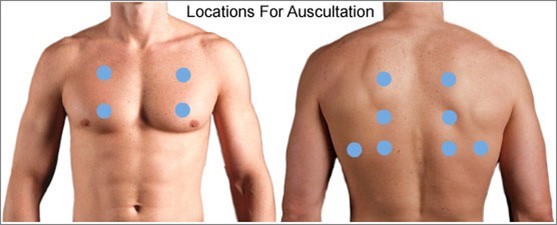The practical nurse (PN) is assessing an older client with left-sided heart failure (HF). What intervention is most important for the PN to implement?
Inspect for sacral edema.
Measure urinary output.
Auscultate all lung fields.
Check mental acuity.
The Correct Answer is C
When assessing an older client with left-sided heart failure (HF), the most important intervention for the practical nurse (PN) to implement is to auscultate all lung fields. Left-sided heart failure is characterized by the inability of the left ventricle to effectively pump blood, leading to fluid accumulation in the lungs. Auscultating all lung fields allows the PN to assess for the presence of abnormal lung sounds such as crackles, indicating pulmonary congestion.
Let's evaluate the other options:
a) Inspect for sacral edema.
Sacral edema is commonly associated with right-sided heart failure, not left-sided heart failure. While it is important to assess for edema in clients with heart failure, inspecting for sacral edema may not be the most immediate and crucial intervention in this specific case.
b) Measure urinary output.
Measuring urinary output is a valuable assessment in many clinical situations, but it may not be the most vital intervention in the context of left-sided heart failure. Monitoring urinary output is more relevant in assessing kidney function and fluid balance rather than directly assessing the severity of left-sided heart failure.
d) Check mental acuity.
Checking mental acuity is important in assessing the overall condition of the client, but it is not the most crucial intervention specifically related to left-sided heart failure. Mental status evaluation is more useful in identifying signs of altered mental status or potential complications, rather than directly assessing the impact of left-sided heart failure.
In summary, when assessing an older client with left-sided heart failure, the most important intervention for the practical nurse (PN) to implement is to auscultate all lung fields. This allows for the detection of abnormal lung sounds associated with pulmonary congestion, a hallmark sign of left-sided heart failure.

Nursing Test Bank
Naxlex Comprehensive Predictor Exams
Related Questions
Correct Answer is ["A","D"]
Explanation
Choice A rationale:
The educational materials should contain a list with definitions of unfamiliar terms because older clients may not be familiar with medical terminology. Providing definitions can enhance their understanding of the new antihypertensive medications and promote medication adherence.
Choice B rationale:
Writing materials at a twelfth-grade reading level may not be appropriate for older clients. Many older individuals may have lower literacy levels, and using complex language can lead to confusion and hinder comprehension. Simple and clear language is more effective in educating this population.
Choice C rationale:
Using common words with few syllables is important for ensuring that older clients can easily understand the educational materials. Complex language and lengthy words can make it difficult for them to grasp important information about their antihypertensive medications.
Choice D rationale:
Using pictures to help illustrate complex ideas is essential when educating older clients. Visual aids can enhance comprehension and retention of information, especially for individuals who may have cognitive impairments or difficulty with written text.
Choice E rationale:
Printing materials using a 12-point type font is important for ensuring that the text is easy to read for older clients. Smaller fonts can be challenging for individuals with visual impairments, and readability is crucial for effective education.
Correct Answer is A
Explanation
Choice A rationale:
"Phobias are characterized by persistent and irrational fear" (Choice A) is an accurate statement. Phobias are defined by the presence of an intense and irrational fear of a specific object or situation. This fear is persistent and often leads to avoidance behaviors, which can significantly impact the individual's daily life.
Choice B rationale:
"Phobias can be caused by biological factors only" (Choice B) is an inaccurate statement. Phobias can have various causes, including both biological and psychological factors. While there may be genetic predispositions to certain phobias, psychological factors, such as traumatic experiences or learned behaviors, can also contribute to the development of phobias.
Choice C rationale:
"Phobias can be diagnosed based on physical symptoms" (Choice C) is an inaccurate statement. Phobias are typically diagnosed based on the individual's reported symptoms, such as intense fear and avoidance behaviors. There are no specific physical symptoms that directly indicate the presence of a phobia.
Choice D rationale:
"Phobias can be managed with medication alone" (Choice D) is an inaccurate statement. Medication alone is not considered the primary treatment for phobias. While medications like selective serotonin reuptake inhibitors (SSRIs) or benzodiazepines may be prescribed to alleviate anxiety symptoms, the most effective treatment for phobias is psychotherapy, particularly exposure therapy or cognitive-behavioral therapy. These therapies address the root causes of the phobia and help individuals learn to manage their fear.
Whether you are a student looking to ace your exams or a practicing nurse seeking to enhance your expertise , our nursing education contents will empower you with the confidence and competence to make a difference in the lives of patients and become a respected leader in the healthcare field.
Visit Naxlex, invest in your future and unlock endless possibilities with our unparalleled nursing education contents today
Report Wrong Answer on the Current Question
Do you disagree with the answer? If yes, what is your expected answer? Explain.
Kindly be descriptive with the issue you are facing.
